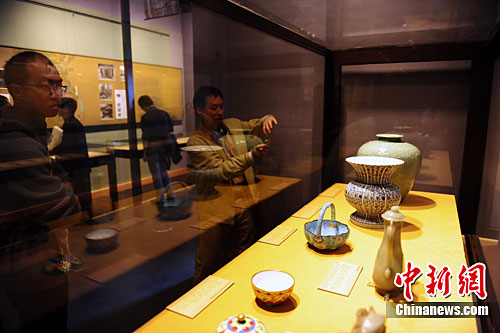Palace Museum exhibition recounts wartime artifact protection
The Palace Museum is holding an exhibition to present the history of a massive transfer of artifacts that took place saving thousands of imperial treasures during the 1930s and 1940s.
|
|
Provided by the Palace Museum in Beijing and Taipei Palace Museum, over 400 sets of historical documents, photos and relics about the transfer were exhibited Sunday at the Shenwumen Gate Exhibition Hall of the Forbidden City. The exhibition is scheduled to last for three months.
After the Japanese army invaded Northeast China in 1931, government officials made a decision to move the Forbidden City's most valuable treasures to southern China, a monumental task that took years of meticulous work. After 1949, some relics returned to Beijing while others went to Taiwan.
"It was a miracle," said Li Wenru, deputy director of the Palace Museum. "Countless treasures in more than 13,000 boxes traveled over 10,000 kilometers by train, water and air, with nothing lost or damaged."
It took the museum six months to prepare for the exhibition. Besides collecting historical data, historians from both museums also jointly embarked on a two-week research trip retracing the route in June.
They visited where the treasures passed through, interviewed witnesses and children of those who worked in the transfer, as well as held sessions with local historians to further complete their research.
Some of their findings and stories about the trip are included in the exhibition.
"Looking back on how the older generation protected these relics reminds us of the responsibility of our own," said Zheng Xinmiao, director of the Palace Museum.
The exhibition marks the 590th anniversary of the Forbidden City and the 85th anni-versary of the museum.
Other ongoing events at the Forbidden City include a seminar on the Forbidden City's history and an exhibition of relics from the Yongle, Hongxi and Xuande periods (1403-35) of the Ming Dynasty (1368-1644).
 0
0 








Go to Forum >>0 Comments